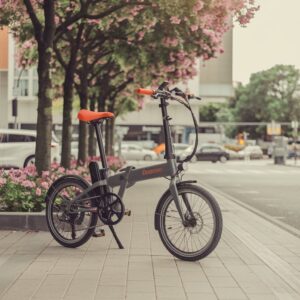Daily Commute E-bike Guide
Ditching the car for an electric bike can make your daily commute smoother, faster, and more enjoyable. With traffic jams and parking troubles becoming a regular hassle, it’s time to consider a change. E-bikes offer a sustainable and efficient way to navigate urban landscapes while providing an exhilarating ride. This guide will help you understand how to enhance your daily commute with an e-bike.
The Daily Commute: A Modern-Day Struggle
Everyday traffic congestion adds stress to our lives. The time spent stuck in traffic could be better used. Commuters lose valuable hours, leading to frustration and even fatigue. As cities grow, so do the challenges of getting around.
E-bikes: A Sustainable and Efficient Solution
E-bikes provide an attractive alternative. They combine the convenience of biking with a little boost from electric power, allowing you to travel further and faster without breaking a sweat. These bikes are eco-friendly, reducing the carbon emissions associated with traditional cars.
Why This Guide is Essential for Your Commute
Understanding the ins and outs of e-bike commuting can transform your daily experience. With practical tips and insights, this guide will show how to make the most of your e-bike rides.
Choosing the Right E-bike for Your Commute
Types of E-bikes: Understanding the Options
E-bikes come in three classes, each catering to different needs:
- Class 1: Pedal-assist only, no throttle. Ideal for those who enjoy a workout.
- Class 2: Throttle-based. Perfect for casual riders who want to take it easy.
- Class 3: Fast pedal-assist, typically allowing speeds up to 28 mph. Great for longer commutes.
Factors to Consider: Budget, Distance, Terrain, and Features
When selecting an e-bike, think about:
- Budget: E-bikes can range from $600 to over $3,000. Set a budget that fits your needs.
- Distance: Plan for how far you’ll ride each day. Some bikes can travel over 50 miles on a single charge.
- Terrain: Consider the kind of paths you’ll encounter. Mountain e-bikes work better on rough trails than city bikes.
- Features: Look for options like integrated lights, racks, and easy-to-read displays.
Daily Commute E-bike: Real-World Examples of Choices
- City Commute: A Class 2 e-bike with a lightweight frame and quick battery charge is ideal.
- Suburban Commute: A Class 3 e-bike with a robust battery and comfortable seating can handle longer distances.
Safety First: Mastering E-bike Commuting
Essential Safety Gear
To ride safely:
- Helmet: Always wear one to protect your head.
- Lights: Use front and rear lights for visibility.
- High-Visibility Clothing: Bright colors help you stand out.
Rules of the Road
Understand e-bike laws in your area. Most places designate bike lanes and rules similar to those for bicycles. Always adhere to local traffic regulations.
Defensive Riding Techniques
Stay alert. Anticipate hazards like potholes or opening car doors. Always assume drivers may not see you. Use hand signals to indicate turns or stops.
Maintaining Your E-bike for a Smooth Commute
Regular Maintenance Checks
Keep your e-bike in good shape by checking:
- Tires: Ensure they are properly inflated.
- Brakes: Test brakes frequently for responsiveness.
- Battery: Monitor battery health and charge level.
Troubleshooting Common Issues
- Flat Tires: Know how to change a tire quickly.
- Battery Problems: Familiarize yourself with your battery care routine.
Resources for Repairs and Maintenance
Local bike shops offer repair services. Online tutorials can help you learn basic maintenance tasks at home.
The Environmental and Economic Benefits of E-bike Commuting
Reducing Carbon Footprint
E-bikes help lower emissions. Studies show they emit significantly less CO2 than cars. Switching to an e-bike can cut your weekly carbon output drastically.
 Saving Money on Fuel and Transportation Costs
Saving Money on Fuel and Transportation Costs
Owning an e-bike saves money. Consider these savings:
- No fuel costs: E-bikes run on electricity, which is cheaper than gas.
- Less maintenance: E-bikes require fewer repairs than cars.
Government Incentives and Programs
Many regions offer incentives for e-bike purchases. These can include tax credits and rebates, making your investment more affordable.
Integrating E-bike Commuting into Your Lifestyle
Planning Your Route
Navigation apps can help you find the best bike paths. Routes that avoid busy roads increase safety and enjoyment.
Charging Solutions
Consider where you will recharge:
- Home Charging: Purchase a wall charger for overnight charging.
- Workplace Charging: Check if your job provides charging stations.
- Public Charging Stations: Use apps to locate nearby charging points while out.
Long-term Commitment
Creating a routine ensures your e-bike commuting becomes a habit. Try setting specific days for biking to work or making it part of your weekly exercise plan.
Daily Commute E-bike: Embrace the E-bike Revolution for a Better Commute
E-bikes not only enhance your commute but also promote a healthier lifestyle and a greener planet.
Key Takeaways
- E-bikes reduce travel time and stress.
- Prioritize safety with proper gear and knowledge of the rules.
- Regular maintenance keeps your e-bike functioning well.
Future Trends in E-bike Technology and Commuting
Expect to see advancements in battery technology and smart features in e-bikes soon. The future of commuting is bright, and e-bikes are leading the charge.
